Geothermal projects could meet CanadaÂ’s needs
The study, published online in the Journal of Geophysics and Geoengineering, reports on the potential of using enhanced geothermal systems EGS to tap hot temperatures kilometres below the earthÂ’s surface as a way of generating clean electricity.
It found that the most promising Canadian sites are located in parts of British Columbia, Alberta and Saskatchewan at depths ranging from 3.5 to 6.5 kilometres. Drill deeper, however, and the potential extends right across the country – including parts of Ontario.
“At 10 kilometres we can expect EGS temperatures in the 150 to 200 degrees C range across most of Canada, except some areas of the Canadian shield,” wrote Stephen Grasby, a geologist with the Geological Survey of Canada, and co-author Jacek Majorowicz, an Alberta-based geothermal consultant.
“Given the widespread distribution of geothermal energy, and the high energy content, the potential geothermal resource in Canada is significant,” they concluded.
The findings aren’t surprising – I’ve been pounding on this drum for several years now. But it’s encouraging to finally see it expressed in a peer-reviewed journal. Canada, shamefully, is the only country along the so-called Pacific Ring of Fire that has yet to switch on a conventional geothermal power plant.
The irony is that Canada is home to several of the continent’s leading geothermal power developers. Problem is they’re mostly developing in Nevada, California, Nicaragua, Iceland, Chile – everywhere except Canada, where no formal development program exists.
Maybe now the federal and provincial governments will take the issue more seriously.
This new Canadian study comes three years after the release of a groundbreaking U.S. study led by experts at the Massachusetts Institute of Technology. Their research suggested EGS in the United States could realistically supply about 100,000 megawatts of power generation capacity by 2050, assuming the proper policies and R&D investments were committed.
For comparison, 100,000 megawatts – or 100 gigawatts — is roughly 80 per cent of Canada’s current power generation capacity. It’s about one-twelfth of current U.S. capacity. And the MIT-led group predicted it could be built less expensively than building new nuclear plants or investing in carbon capture and storage technologies for coal plants.
When the MIT-led study came out I lamented that Canada didn’t have similar research to spur development of “heat mining” projects on our own turf, particularly in Alberta where most of the electricity comes from coal-fired power plants.
I should clarify that not all geothermal power plants are created equally. Conventional geothermal projects, like those found in places such as California or Iceland, benefit from ideal rock conditions – that is, porous rock that water can penetrate. They also have naturally occurring hot-water reservoirs.
EGS is more complex. These “enhanced” projects must be engineered to create the conditions required for generating power. Subsurface rock must be hydraulically fractured to create cracks that water can travel through. An outside source of water is also required, adding to the cost of the venture.
Under the EGS scenario, water is pumped into a well and forced to seep into cracks and pores in the rock, where the temperature is ideally above 150 degrees C. The water absorbs the heat in the rock and is pumped back to the surface through a return well. Heat exchangers then extract the heat from the water to create steam, which turns an electricity-generating turbine. The water is then pumped back underground as part of a continuous cycle.
The Canadian Geothermal Association believes Canada, if determined, could develop 5,000 megawatts of geothermal power by 2015 – and that’s just conventional geothermal with temperatures above 200 degrees C and wells less than three kilometres deep. This is the low-hanging fruit we’ve left dangling for decades.
Add to the equation the new technologies that make EGS possible and geothermal power could play the kind of role that hydroelectric power has historically played in Canada, particularly in western CanadaÂ’s many hot spots.
Grasby and Majorowicz estimate that 2 per cent of the entire resource could be recovered for electricity generation. It may sound like a small number, and even that could take many decades to develop, but donÂ’t let that fool you.
“This would still provide a significant contribution towards Canadian energy consumption.”
Maybe itÂ’s time we prove it.
Related News

EDF and France reach deal on electricity prices-source
PARIS - State-controlled power group EDF and the French government have reached a tentative deal on future nuclear power prices, a source close to the government said on Monday, ending months of tense negotiations.
The two sides agreed on 70 euros per megawatt hour (MWH) as a reference level for power prices, the source said, cautioning that details of the deal are still being finalised.
The negotiations aimed to find a compromise between EDF, which is eager to maximise revenues to fund investments, and the government, keen to keep electricity bills for French households and businesses as low as possible.
EDF declined to…





